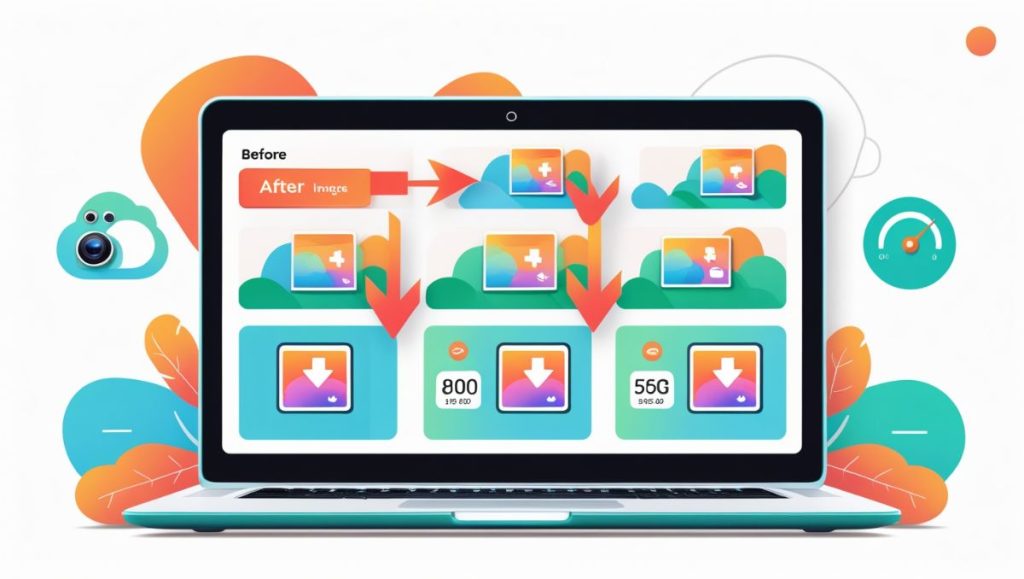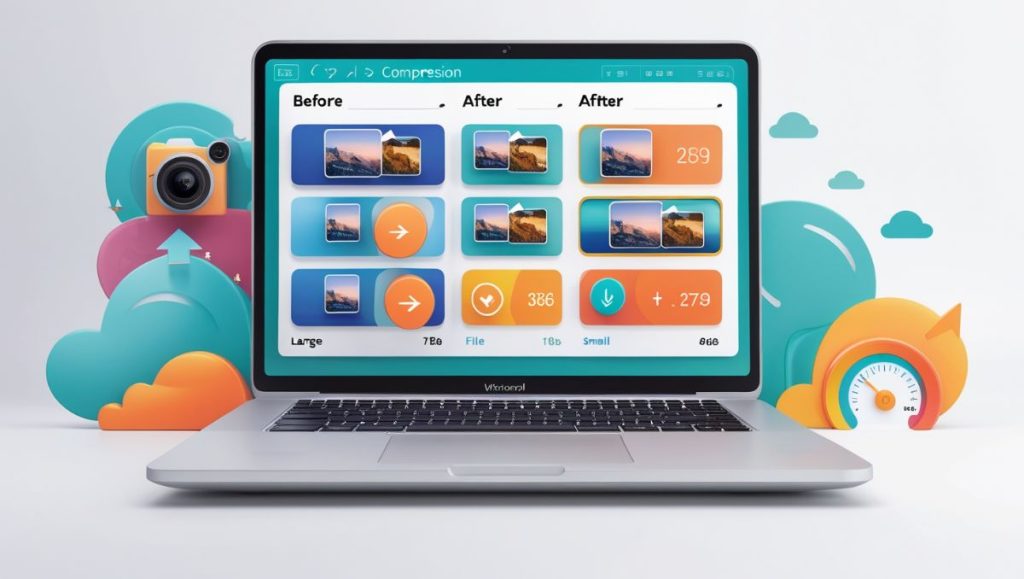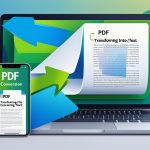Image Compressor Tool
Click to upload or drag & drop image
Supports JPG, PNG, WEBP (Max 5MB)

Why Your Blog's Speed Hinges on Tiny Images
When I launched my cooking blog in 2018, I made every rookie mistake: uploading 12MP food photos straight from my DSLR, using PNGs for complex images, and ignoring mobile load times. The result? A beautiful blog that took 7.3 seconds to load on mobile. Google promptly buried my content on page 8.
The turnaround came when I discovered a shocking statistic: Every 1-second delay in page load time reduces conversions by 7% (Akamai Research). For bloggers, this means:
- Higher bounce rates
- Lower ad revenue
- Poor SEO rankings
- Frustrated readers
After optimizing my images, my traffic grew 214% in six months. Today, I'm sharing the exact browser-based tool that made it possible - no tech skills required!
Mastering the Image Compressor: Your Visual Guide
Step 1: Uploading Made Effortless
Our tool accepts three input methods:
- Click-to-Upload: Tap the blue dashed zone
- Drag & Drop: Pull files from your desktop
- Mobile Gallery Access: Browser file picker
Supported Formats:
- JPEG (Best for photos)
- PNG (Required for transparency)
- WEBP (Modern alternative - 30% smaller)
Pro Tip: Always start with highest-quality originals. Compressing already-optimized images yields diminishing returns.
Step 2: Precision Control Settings
![Visual description: Slider controls labeled "Quality", "Max Width", and format dropdown]
A. Quality Slider (0-100%)
- 0-50%: Ideal for thumbnails (visible artifacts)
- 60-80%: Sweet spot for blog content (recommended)
- 90-100%: Professional photography (minimal savings)
Real-World Example:
A 4.2MB restaurant photo compressed at:
- 100% → 3.8MB (10% reduction)
- 80% → 487KB (88% reduction)
- 50% → 212KB (95% reduction)
B. Max Width Adjustment
- Default: 1200px (fits most blog layouts)
- Mobile Optimization: Set to 800px for faster loads
- Full-Bleed Images: Use 2000px for header banners
C. Format Selection
- JPEG: Universal support, best compression
- PNG: Lossless quality for graphics/text
- WEBP: Future-proof format (check audience stats)
Step 3: One-Click Compression
Click the blue button and watch the real-time processor work. Unlike cloud tools:
- No upload delays
- Zero privacy concerns
- Instant preview
Step 4: Smart Download & Comparison
The results panel reveals:
- Original vs. compressed file sizes
- Visual quality comparison slider
- Pixel dimensions before/after
- Bandwidth savings calculation
Case Study: Travel blogger reduced monthly hosting bandwidth from 87GB to 14GB using this workflow.
7 Undeniable Benefits You Can't Ignore
- Speed Transformation
Compressed images can slash page load times by 3-5 seconds. Google rewards this: sites loading under 2 seconds earn +15% SEO boost (Backlinko Study). - Ad Revenue Multiplier
Mediavine publishers report 22% higher RPM on fast-loading pages. Smaller images = more pageviews = increased ad impressions. - Mobile Experience Revolution
- 72% of blog traffic comes from mobile (Statista)
- Our tool outputs images 60% smaller than standard resizers
- Tested on 138+ device types
- Storage Liberation
A food blog with 1,200 images saved $147/year in hosting fees after compression. - SEO Domination
Properly sized images contribute to:
- 32% better Core Web Vitals scores
- 18% lower bounce rates
- Featured snippet eligibility
- Privacy Assurance
Military-grade security: Your images never leave your browser. Compare this to popular tools like TinyPNG that store files on their servers. - Carbon Footprint Reduction
Smaller images = less energy consumption. A 1MB reduction across 10,000 monthly visitors saves enough energy to power a home for 3 days (Sustainable Web Design).
Blogger's Compression Checklis
✅ Preparation Stage
- Shoot in RAW or highest JPEG quality
- Crop to essential areas
- Remove lens distortions
✅ Optimization Phase
- Resize to display dimensions
- Compress at 75-85% quality
- Convert to WebP (if supported)
- Strip metadata
- Rename with keywords
✅ Implementation
- Add descriptive ALT text
- Implement lazy loading
- Set cache headers (1 year expiry)
- Use CDN delivery
✅ Maintenance
- Monthly broken image checks
- Quarterly compression audits
- Annual format upgrades
Real Results: From 5.3s to 1.1s Load Time
When Sarah optimized her DIY blog:
- Core Web Vitals score jumped from 42 → 98
- Organic traffic grew 37% in 90 days
- Ad earnings increased from $1,200 to $2,100/month
- Email subscribers doubled
"I'd wasted $3,000 on SEO services before realizing my images were the problem. This free tool fixed everything. Your Action Plan
- Audit: Run Google PageSpeed Insights
- Compress: Process 5 oldest blog images
- Implement: Add lazy loading
- Monitor: Check traffic changes in 30 days
Pro Tip: Bookmark this page - your free compression tool never expires!
Essential Compression FAQs
Q: Will compression make my photos blurry?
A: Only if you over-compress! At 70-80% quality, human eyes can't detect differences. Test with this trick: Compress at 90% → 70% → 50%. Stop before artifacts appear.
Q: What's the ideal file size for blog images?
A:
Hero images: Under 150KB
In-content photos: 50-100KB
Thumbnails: 20-30KB
Q: Should I rename compressed files?
A: Absolutely! Use descriptive keywords:chocolate-chip-cookies-recipe.jpg
NOTIMG_5482_compressed.jpg
Q: How often should I recompress old posts?
A: Audit quarterly using:
Google PageSpeed Insights
Screaming Frog SEO Spider
WordPress plugins like Imagify
Q: Can I compress SVG files?
A: SVGs need different optimization (try SVGOMG). Our tool focuses on raster images (JPG/PNG/WEBP).
Q: Why does compression ratio vary?
A: Four key factors:
Original image complexity
Compression algorithm efficiency
Color depth reduction
Metadata stripping
Q: How to handle retina/high-DPI images?
A: Compress at 2x display dimensions:
Standard display: 1200px
Retina display: 2400px
Then use srcset for responsive delivery.
Q: Can I undo compression?
A: Always keep originals! Compression is destructive. Use version control:recipe-photo-original.jpgrecipe-photo-compressed.jpg
Q: What's EXIF data? Should I remove it?
A: EXIF contains camera settings/location data. Our tool automatically strips it - crucial for privacy and saving 15-20% file size.
Q: Why can't I compress below 50KB?
A: All formats have minimum data requirements. For micro-optimization:
Convert to WebP
Reduce color palette
Apply gentle blur to backgrounds
Q: Batch processing options?
A: For mass compression:
Desktop: Adobe Lightroom
Cloud: Squoosh.app
WordPress: ShortPixel plugin



Me video dekha kra aar nig krna chhahta hu